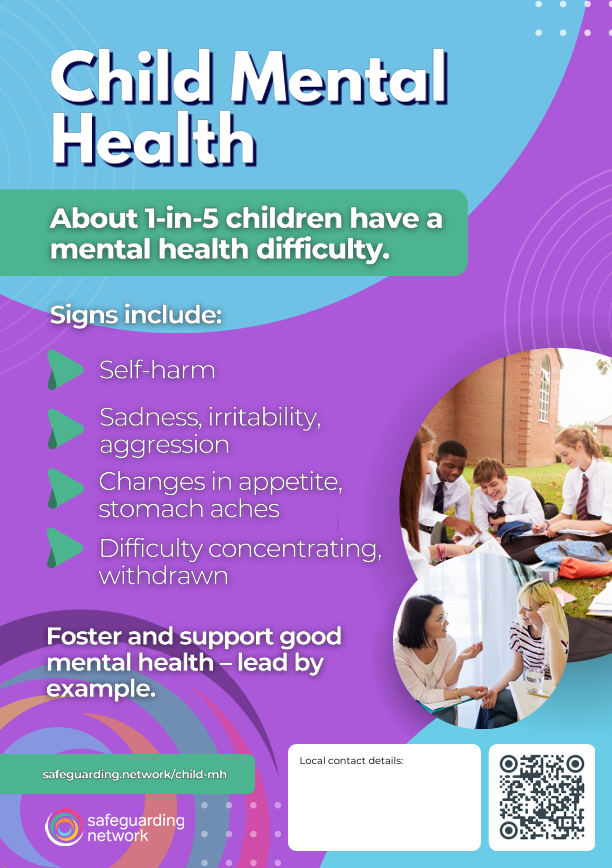Introduction
Mental health is a subject that many of us find difficult to discuss, primarily because we worry about saying the wrong thing and making matters worse.
Mental health continues to be a growing concern. According to Mind, around 1-in-5 children or young people have a mental health difficulty, but only a third were able to access treatment in England last year.
Need more?
Thank you for visiting our resources pages. These are free to everyone as is our fortnightly safeguarding bulletin – general safeguarding information is too important to restrict. Become a member to access lots more, including training materials for you to deliver in-house on each topic in Keeping Children Safe in Education.
Sign up for FREE fortnightly bulletin.
What about training?
We can deliver training for your setting on this and other subjects via online platforms, or face-to-face in certain areas. Just get in touch to discuss your requirements.
As with adults, children’s mental health issues can vary, and whilst some children and young people self-harm or contemplate taking their own lives, this is not the case for everyone.
It's important that we don’t ignore it and hope it all goes away. Stigma is a significant issue when suffering from mental ill-health. We must lead by example and educate children and young people about mental health and how to help others who may be experiencing problems.
Definition
Mental health is a state of mental well-being that enables people to cope with the stresses of life, realise their abilities, learn well and work well, and contribute to their community. It is an integral component of health and well-being that underpins our individual and collective abilities to make decisions, build relationships and shape the world we live in. Mental health is a basic human right.
What helps good mental health?
For children to remain mentally well they need:
- good physical health (including good diet and regular exercise)
- to be able to explore and develop interests (through their environment, play and interaction with others)
- to feel part of a family (feeling as though they belong, get along with others, are loved, valued and safe)
- to be supported to learn, be optimistic and feel that they have a say
- to feel part of a community (e.g., their education setting, a local community group, etc.)
- to be supported to cope when things do not go well
- to be supported when learning how to solve problems.
Risks
As with all situations, there are certain factors that may increase the risks of poor mental health:
- parental issues (e.g., substance or alcohol misuse, mental health issues, family members in prison)
- loss within the family (e.g., parents who separate or divorce, bereavement)
- experience of abuse (physical, sexual or emotional) or neglect
- experience of being bullied
- living in poverty or experiencing homelessness
- being a young carer
- experiencing significant issues at school, such as exam stress.
Spot the signs
Children and young people can show signs of poor mental health in emotional, behavioural and physical ways.
Emotional signs include:
- crying more than usual
- prolonged sadness
- irritability and aggression – particularly if this manifests in regular, unprompted outbursts
- appearing bored more often than normal
- talking about topics such as death or suicide.
Behavioural signs include:
- young children may become clingier, while older children may be more withdrawn
- losing interest in friends and hobbies
- being reluctant to talk
- difficulty concentrating.
Physical signs:
- changes in appetite
- insomnia or disrupted sleep patterns
- increased incidences of bed wetting for younger children
- frequent headaches or stomach aches
- rapid loss of weight
- teeth grinding
- loss of hair
- self-harm.
What to do
- Create a whole-setting culture where children and young people feel confident to talk openly about their mental health.
- Talk with the child or young person – talking is often key. It may be that the initial conversation has nothing to do with their mental health and instead is more general, but this will build trust and understanding.
- Stay informed about where a child or young person can find appropriate support material to go over in their own time at their own pace.
- Encourage a healthy lifestyle (e.g., good nutrition and taking exercise).
- Help the child or young person understand what they are feeling – for example everyone has fears and worries about things and part of growing up is learning how to deal with these.
- Follow your safeguarding procedures and share your concerns with the appropriate member of your safeguarding team.
- Get support for yourself – you don’t need to know all the answers, however, you do need to be sure that there is nothing further that can be done.
Starting difficult conversations
If you're worried about a young person, try to get them to talk to you. Often, they will want to talk but will not speak until someone asks how they are.
- As when dealing with disclosures, use open ended questions. For example: “Tell me about…”, “How do you feel about …” and “What happened about …”.
- Repeat back what they say to show that you understand.
- Do not try to solve the problem – that will come over time. Initially focus on their feelings – this can be of more help and show that you care.
- Try to let them make their own decisions – they are more likely to stick to what they decide than to follow what they are told to do by someone else.
- Be careful not to fall into the trap of trying to fix everything or dish out advice – let them lead the conversation and identify what they want to happen.
- Remember you do not need to be an expert to be able to help.
- Remember that everyone is different – an approach that worked with one young person may not work with another.
(adapted from the Samaritans advice page)
What about self harm and suicide?
Most children and young people do not get to a point where they are self-harming or considering taking their own life. For those that do, it's important that this is recognised, and appropriate support is put in place.
Contrary to some belief, self-harm is not attention seeking. Often, it is a coping mechanism to stop the child/young person feeling that things are getting out of control – the Samaritans have a handout looking at common myths around self-harm. If a child or young person is expressing suicidal ideation, it’s important that you get help and support immediately.
Starting conversations about suicide can be daunting for everyone. Papyrus (a charity working to help prevent young suicide) emphasises the importance of empowering others to reach out for support if they are experiencing thoughts of suicide and helping them find suitable services or support them.
Free child mental health poster
This free, downloadable resource raises the profile of safeguarding for your staff team. For use in staff rooms, on safeguarding boards or on the back of toilet doors, the poster includes tips, a space for local contact details, plus a link and QR codes to this resource page. Download the poster from the resources below.
DSL Training Materials
-

Children's Mental Health and Substance Misuse Presentation
-

Children's Mental Health and Substance Misuse - Presenter Notes
-

Handout for staff - Children's Mental Health
-

Child Mental Health – Quiz
-

Child Mental Health – Quiz (Answer Sheet)
-

Child Mental Health Scenario – Early Years Settings
-

Child Mental Health Scenario (Early Years) – DSL Information Sheet
-

Child Mental Health Scenario – Primary Schools
-

Child Mental Health Scenario (Primary) – DSL Information Sheet
-

Child Mental Health scenario – Secondary Schools
-

Child Mental Health Scenario (Secondary) – DSL Information Sheet
-

Child Mental Health Scenario – 16+ settings
-

Child Mental Health Scenario (16+) – DSL Information Sheet
-

Child Mental Health Scenario (SEND) – DSL Information Sheet
-

Child Mental Health Scenario – SEND settings
-

Child Mental Health Scenario – Care Settings
-

Child Mental Health Scenario (Care) – DSL Information Sheet
Resources
-

Child mental health poster
-

Social media, young people and mental health
-

Whole school or college approach (WSCA) measurement toolkit
-

Measuring pupil wellbeing
-

Addressing School Avoidance
-

HOPELINE247
-

Mental Health Support: Absolutely Not
-

Taking CARE To Promote Mental Health in Schools and Colleges
-

Promoting children and young people’s emotional health and wellbeing
-

Building suicide-safer schools and colleges
-

Responding to critical incidents in educational communities
-

Schools in Mind
-

Mental health and behaviour in schools
-

The truth about self-harm: for young people and their friends and families
-

Mentally healthy schools
-

Mental health advice for parents and carers
-

We All Have Mental Health: Animation & Teacher Toolkit
-

Anti-racism and mental health in schools
-

Trauma Bereavement
Save time and improve your safeguarding approach…
Bite-size training materials to share with your staff every month.
Support to explore and develop your safeguarding culture.
A huge array of resources and professional experience at your fingertips.
Get in touch now for a personal tour of the site and details of membership benefits.
We look forward to working with you.


